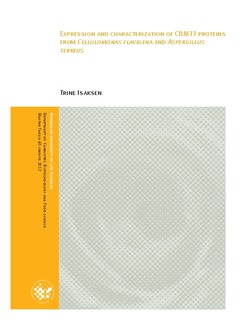| dc.description.abstract | An essential element of a modern biorefinery is the enzymatic conversion of biomass to soluble sugars. Although the optimization of this process has been pursued by both academia and industry for decades, it still represents a bottleneck in the biorefinery concept. Recent discoveries of a lytic polysaccharide monooxygenase (LPM) activity among members of family 33 of carbohydrate binding modules (CBM33), boosting the degradation of recalcitrant polysaccharides, have given more insight to the degradation of complex polysaccharides in nature that could be adapted for biorefining processes. These findings have also prompted an effort in cloning, expressing and characterizing a wide variety of CBM33s in order to get information on CBM33-family diversity in terms of function and mechanism.
The genome of the Gram negative soil bacterium Cellulomonas flavigena encodes four CBM33s (CfCBM33s), all possessing C-terminal CBM2a domains, indicating substrate specificity towards either cellulose or chitin. The bacterium is previously known to metabolize cellulose and xylan. Conversely, results from binding and activity assays performed with two of the CfCBM33s (CfCBM33A-N and CfCBM33B-N) in this study show no specificity towards either of these substrates. However, both show affinity for chitin, which is intriguing as the genome of C. flavigena contains no identified chitinases. In addition to the unexpected binding affinity towards chitin, CfCBM33B-N shows lytic chitin monooxygenase activity and is also able to boost the degradation of β-chitin by chitinase A, B and C from Serratia marcescens. Moreover, intriguingly, CfCBM33B-N generates partly deacetylated products from the oxidation of β-chitin possibly showing a new function or binding specificity not previously reported for LPMs.
Finally, a CBM33 containing a CBM20 (indicating binding affinity for starch) from the fungus Aspergillus terreus was successfully cloned and expressed in Pichia pastoris. Preliminary binding experiments using isothermal titration calorimetry indicate that AtCBM33A binds specifically to starch. Analysis of LPM activity was prevented by the time restrains of this study, but will be the focus of consecutive work. A starch active LPM would be completely new to the field and could be an important finding for the starch processing industry. | no_NO |
